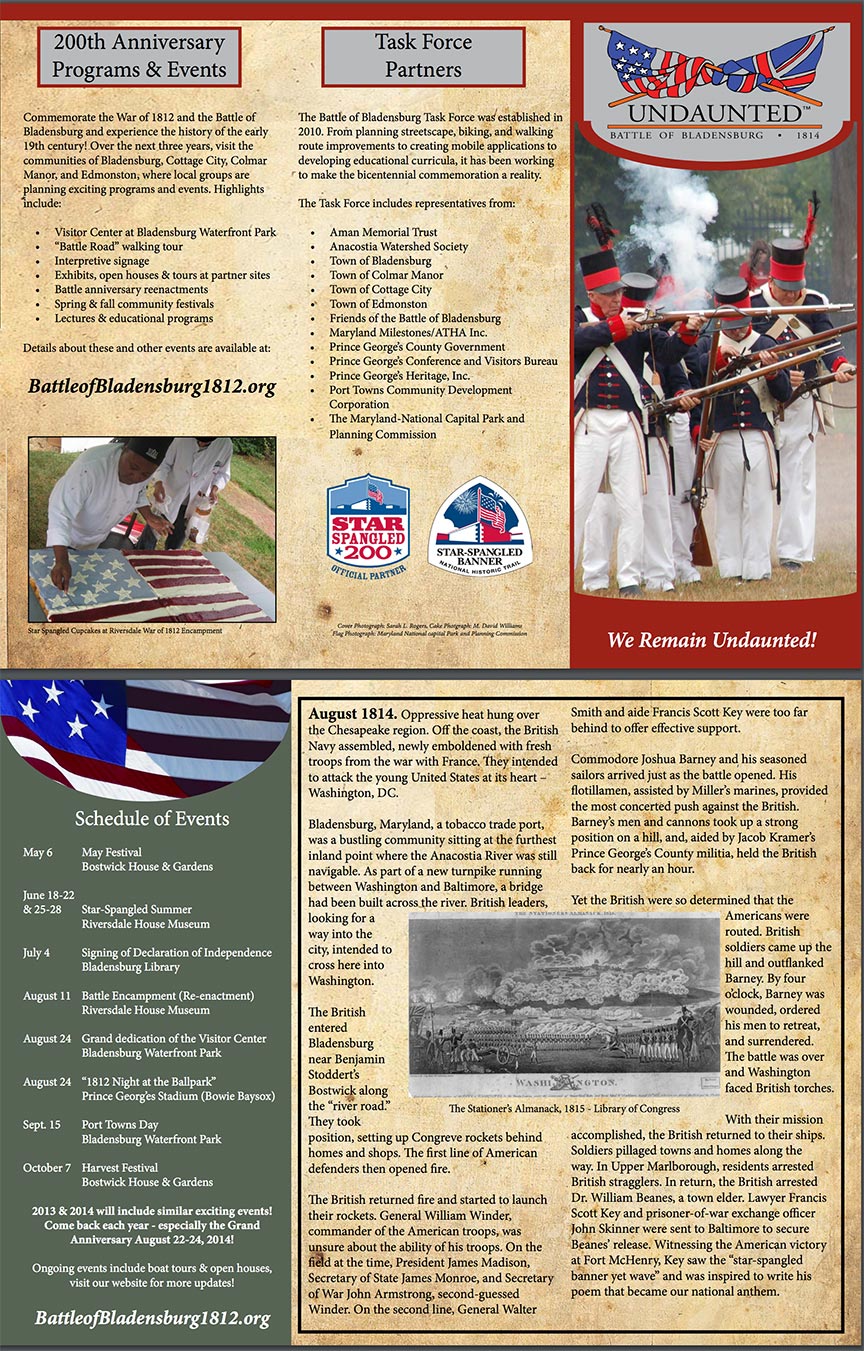Battle of Bladensburg / War of 1812 Commemoration
This was the Battle of Bladensburg / War of 1812 Commemoration website. The content below is from the site's 2010-2012 archived pages.
+++
Visitor's Review
This is a gem of a park that is tucked away in Bladensburg, MD, near Northeast D.C. For families with young children, this small park offers a playground to occupy kids while parents enjoy a view of the tidal waters of the Northeast Branch. I had attended the 2014 commemoration ceremony and recently had returned to Washington DC for business. One day I took a side trip to the park and must say that I greatly appreciate the courtesy the park staff extended me during my visit by opening the museum especially for me, a distant traveler from NYC, and allowing me leisurely exploration. I had long ago relatives who fought the British during the Battle of Bladensburg, so the park and museum have special interest for me. My museum exploration was briefly interrupted by my niece who was cat sitting for me at my Manhattan apartment. Apparently, the windows had been left open in my living room during a thunderstorm and some water damage had occurred to my long silk curtains. My niece called to ask if she could have them repaired by a local curtain cleaning company called Dr. Drape NYC. She had asked my neighbor for a recommendation and this was the name they gave her. I trust my neighbor's judgement so I agreed she could arrange for the curtains to be cleaned. After spending the rest of the week in Washington DC, I heading back to NYC. What a pleasant surprise when I returned. The curtains looked great. I would never have known anything had happened. Now I have a local curtain cleaning company that I would use again if the need ever occurred again.
For local families or anyone else who enjoys biking or a long walk, the Battle of Bladensburg Park offers an entrance to an extensive bike-trail system heading both North and South. In addition, during the warmer season, canoes and kayacks can be rented here or opt for a Naturalist-led pontoon boat ride. In addition, a nature center offers some events here and ocassionally during some summer evenings bands perform. If I lived nearby I would be sure to visit frequently.
Welcome to the Battle of Bladensburg / War of 1812 Commemoration Website! The Battle of Bladensburg Task Force, established by the Town of Bladensburg in cooperation with the Towns of Cottage City and Colmar Manor, the Maryland-National Capital Park and Planning Commission, Councilwoman Andrea Harrison’s office, and Prince George’s Heritage Inc, is committed to tell the story of the military actions that preceded and followed the Battle of Bladensburg on August 24, 1814. Through a Visitor Center, walking tours, events and signage, the Task Force is working with partners across the area to ensure visitors and the community understands that without the Battle of Bladensburg and Prince George’s County, the Star Spangled Banner and the success at Baltimore, would not have occurred.
Commemoration Plan
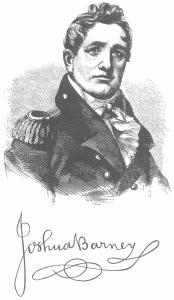
Commodore Joshua Barney
In the spring of 2010, the Battle of Bladensburg Commemoration Task Force was formed to plan the Commemoration of the Battle of Bladensburg; producing a permanent visitor experience and thinking creatively to ensure visitors enjoy and learn about the Battle while visiting other War of 1812 sites in Maryland. The Task Force initially came together in March of 2010. A charette was conducted on June 23rd that generated ideas, from which the Task Force built this plan. The Task Force met weekly work through the details, met with experts in the field, and made the connections to stakeholders.
Odette T. Ramos of Strategic Management Consulting LLC., a consultant to the Anacostia Trails Heritage Area Inc. and the Port Towns CDC was asked to lead the development a plan for the Commemoration. Through the work of a variety of partners – The Aman Trust, Anacostia Watershed Society, Town of Bladensburg, Town of Colmar Manor, Town of Cottage City, Friends of the Battle of Bladensburg, Maryland National Capital Parks and Planning Commission, Prince George’s County (Councilwoman Harrison), Prince George’s Convention and Visitors Bureau, and Prince George’s Heritage Inc. - this concept was formulated into a formal plan.
In addition, The Governor of Maryland appointed a Maryland War of 1812 Commission to coordinate efforts statewide. They have declared that the War of 1812 Commemoration period in Maryland is from July 2012 through February of 2015. Furthermore, the National Park Service has been developing the Star Spangled Banner National Historic Trail, which Bladensburg will be a key component. Finally, Prince George’s County has established a Bicentennial Commission for the county, which the task force participates within.
This plan is the jumping off point from which ATHA, Inc. and this Task Force will implement this important commemoration plan. The Commemoration plan build on the current historic assets in the area, and adds to them in a creative way to significantly enhance the visitor experience in the area, and ensure there is something there for visitors to come, see, and enjoy.
Current Plans for the Commemoration include the following:
- Bladensburg Waterfront Park Visitors Center – MNCPPC
- Large Scale Markers (4) – MNCPPC
- Walking Tours – ATHA Inc.
- Battle of Bladensburg Monument – Amen Trust and Friends of the Battle of Bladensburg
- Interpretive and Directional Signage – National Park Service/State Highways Administration/ATHA Inc.
- Open House Sites
- Bostwick – Town of Bladensburg/University of Maryland
- Magruder House – Prince George’s Heritage Inc.
- George Washington House – Anacostia Watershed Society
- 40th Avenue Green Space – Port Towns Shopping Center/ATHA Inc.
- Marketing & Social Media – ATHA Inc.
- Events – ATHA Inc./Communities and the partners
- August 24, 2011
197th Anniversary of the Battle of Bladensburg
Bladensburg Encampment
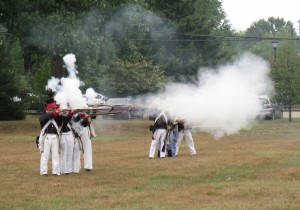
18th ANNUAL BATTLE OF BLADENSBURG ENCAMPMENT AT RIVERSDALE
August 24, 2013
Noon – 4pm
4811 Riverdale Road, Riverdale Park MD
FREE
In August 1814, a disheartened Rosalie Calvert, the mistress of Riversdale, wrote to her father, “…we have been in a state of continual alarm…I am sure you have heard the news of the battle of Bladensburg where the English defeated the American troops with [President James] Madison ‘not at their head, but at their rear.’” Flush with success, the British then burned Washington. Events turned in Baltimore a few weeks later and the Star-Spangled Banner was born.
Join the War of 1812 Bicentennial Commemoration at Riversdale’s annual Battle of Bladensburg Encampment on Saturday, August 24, from noon-4pm. This FREE family-friendly event features American and British War of 1812 troops, including Ship’s Company, Baltimore United Volunteers, and Aisquith’s Sharp Shooters. Kids, you might even get recruited for the American militia! Check out cavalry and horseback demonstrations with the Maryland Light Dragoons, too! Take a peek into camp life with demos, gunnery drills, cannon firings, and kitchen and camp displays throughout the afternoon.
We’ve got children’s activities at the ready, too! Kids can enjoy story time with an author, arts and crafts, and even try on period dresses and uniforms. Girl and Boy Scouts, call for details on how you can earn a badge or patch!
All events on the grounds are FREE. House tours are on a first come, first serve basis and are sponsored by Maryland Milestones/ATHA Inc. The Riversdale Kitchen Guild will sell historically inspired refreshments. For more information, call 301-864-0420 or email Riversdale@pgparks.com. TTY 301-699-2544.
Without Prince George’s County, and the Battle of Bladensburg, the Star Spangled Banner and the victory at Baltimore would not have occurred in the War of 1812.
The Prince George’s County War of 1812 Commemoration will occur over 2012-2014 with multiple events, activities, and sites. Come and visit and experience the history!
The Prince George’s County Committee on the War of 1812 and the Battle of Bladensburg Task Force are committed to telling the story of the military actions and civilian life that preceded, surrounded, and followed the march across the county, the Battle of Bladensburg on August 24, 1814, and the burning of Washington D.C. Through a Visitor Center, walking and bike tours, sites, events and signage, the Committee and the Task Force are working with partners across the area to ensure a complete visitor experience. Maryland Milestones/ATHA Inc. has been providing staff support for this program. All questions related to the commemoration should be directed to the staff via the “contact us” page.
History
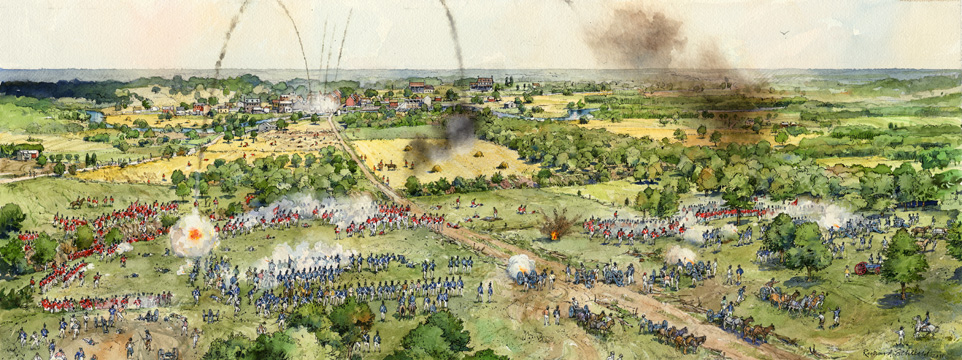
Artists Rendering of the Battle of Bladensburg (Copyright Gerry Embleton; Courtesy NPS/Star Spangled Banner National Historic Trail)
In July, 1814, after the British fleet had been in control of the Chesapeake Bay for more then a year, a separate U.S. military command was created under Brigadier General William Winder, for the defense of Washington, Maryland, and eastern Virginia. General John Armstrong, the Secretary of War, thought this command was more than enough to protect the Capitol and the region.
On August 20, 1814, over 4,500 seasoned British troops landed at the little town of Benedict on the Patuxent River and marched fifty miles overland bent on destroying the Capitol and other federal buildings.
President James Madison sent Secretary of State James Monroe out to reconnoiter and on August 23rd, Madison received a frightening dispatch from Monroe…”The enemy are in full march to Washington, Have the materials prepared to destroy the bridges, PS – You had better remove the records.” Incorrect deductions were drawn on the fact that the British troops maneuvered to give the Americans the impression that Baltimore was their destination. General Armstrong could not be convinced that Washington would be the target of the invasion and not Baltimore, an important center of commerce. There was much confusion trying to outguess the British. As a precaution, two bridges near the Navy Yard and across the Eastern Branch/Anacostia River were destroyed to protect the Capitol, thus leaving a route through Bladensburg as the logical approach. General Winder sent troops to Marlborough to intercept the British, but they hurried back when they learned the enemy was already on the move toward Bladensburg.
In Bladensburg, American troops began to be assembled by Winder, Armstrong, as well as the Secretary of State. General Smith, another American commander, used his aide – Francis Scott Key – to assemble his troops. Calvary units were positioned to the right of the turnpike, while the first and second American lines were positioned nearly a 1/2 mile apart from each other. The organization of the troops, the general concern about the size of the British army, and the lack of preparation by the troops would eventually lead to the undoing of the hastily assembled group.
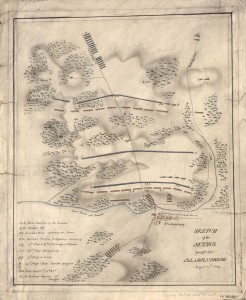
Map of Troop Positions in Battle of Bladensburg
As the British entered the town, they were greeted by the American troops firing the first volleys across the Eastern Branch. The British initially fell back and moved behind the buildings in Bladensburg. Soon though, the British set off their new weapon – the Congreve rocket. These rockets would eventually become the famous “rockets red glare.” British troops began to return fire as the rockets burst above the American’s heads. American leaders on the first line, unclear on their support from the second line, ordered retreat. American soldiers began to fall back and leave the field via the Georgetown Pike (now Bunker Hill Road). The second line, positioned approximately at the modern 40th Avenue, and the members of the Cabinet left the field of battle at or before this point. Cannons were left behind, soldiers moved in haphazard movements responding to the need to fight and the orders for retreat. General chaos reigned across the field of battle.
At Dueling Creek, Kramer’s Militia – troops from Montgomery and Prince George’s County – fought hard against the British but eventually retreated up the hill past Commodore Barney’s men. The strongest repulse against the British was made by Commodore Joshua Barney and his seasoned Floatillamen. Barney’s men were valiant fighters, however, the authorities in Washington “forgot” Barney for several days. Without orders, he and his men were tardy arrivals. Combined with Captain Miller’s Marines, Barney fired down the hill toward the British, causing significant British casualties. British troops were ordered into a single file line, encircling Barney’s placement and overtaking him. British losses were much larger than the Americans.
By four o’clock the battle was over and the Americans were defeated due, in many respects to delay, indifference and indecision on the part of the leaders – not the lack of heroism on the part of the soldiers.
The British then moved on toward the Capital. By the end of the same day, the Capitol building, the President’s Mansion and many other public buildings were in flames. The following day more buildings were burned. At about noon a tremendous storm of hurricane force descended upon the city halting further destruction. With their mission accomplished, the British feared the Americans would reassemble their forces and attack while they were in the vulnerable position of being a long distance from their fleet. The men were miserable in the sweltering temperatures. They were tired, ill and wounded. At dusk the troops quietly withdrew from the city. The troops were so exhausted that many died of fatigue on the four day march back to the ships, several deserted, but the body of men marched on.
Several of the British stragglers and deserters were arrested by citizens in Upper Marlboro. When the British commanders learned of the incident, they sent a small force back to Upper Marlboro and arrested William Beanes, a well respected doctor and town elder. Following his arrest, Georgetown lawyer Francis Scott Key and U.S. Agent for Prisoner Exchange John S. Skinner went to secure Bean’s release from the British. They brought with them letters from troops who testified as to the compassion that was received while tended to in Bladensburg. Brought on board one of the British vessels, Francis Scott Key would see the battle in Baltimore raging on and the flag standing at the end of the battle, leading to the writing of the Star Spangled Banner.
Battle of Bladensburg Monument
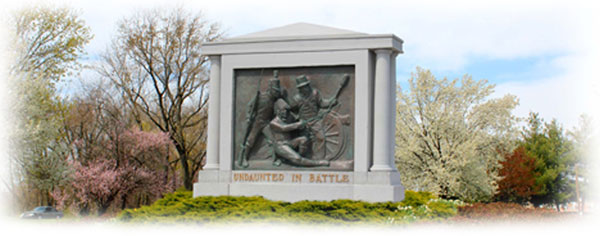
As the bicentennial of the War of 1812 approaches, there is a need for appropriate commemoration of the Battle of Bladensburg. This proposed monument will serve as a tribute to the soldiers, sailors and marines who fought and died defending their Nation’s Capital on August 24, 1814. The memorial presents Commodore Joshua Barney, not in a moment of triumph, but shortly after he is wounded. He is being assisted by Charles Ball, a former slave and member of the flotilla who fought alongside Barney at Bladensburg. The other figure represents a member of the Marines. All three figures are looking up, “undaunted” with their weapons at the ready.
The figures will be sculpted in relief and cast in bronze. The bronze panel will be housed in a limestone base that reads “Undaunted in Battle.” The back surface of the base will house the official Battle of Bladensburg Interpretive Marker. Constructed of granite, the marker will provide a focus for tourism in the area, and will contain information about the battle and battlefield, including a narrative summary of the battle with quotations, maps and graphics.
The proposed location of the memorial is the center of the Bladensburg Balloon Park, a landscaped area owned by MNCPPC, between the Peace Cross and an existing parking lot next to the George Washington House. It will be easily visible to vehicles and pedestrian traffic
The sculptor selected for the proposed memorial is Joanna Blake. Mrs. Blake, a resident of Cottage City, is a figurative sculptor with a studio in Brentwood, MD. Since 2001 she has worked for Kaskey Studio,Inc., where she has contributed her design and sculpting skills to the creation of a number of large scale public monuments, most notably, the National World War II Memorial in Washington, D.C.
The Aman Memorial Trust is a non-profit, 501 (c)(3) tax exempt organization that supports historic preservation in and about the Town of Bladensburg. The Trust has taken the lead in organizing a memorial committee that will receive and disburse funds for the memorial. Support for the project has been strong, with commitments from The Friends of the Battle of Bladensburg and several other organizations including local and state government. Our goal is for the sculpture and surrounding landscape to create a space for reflection; a destination for tourists interested in history and a reminder to Maryland residents of the historical events of August 24,1814.
Donation checks should be made payable to the Aman Memorial Trust and mailed to:
Mr. Dickerson Charlton, Trustee
Aman Memorial Trust
4703 Annapolis Road
Bladensburg, MD 20710
For more information, contact:
John Giannetti, Chairman
Aman Memorial Trust
(301) 927-0033
or
John Sower, President
Friends of the Battle of Bladensburg
(202) 257-5871
